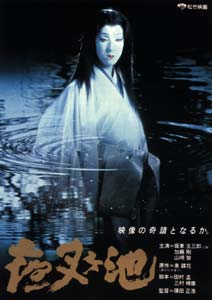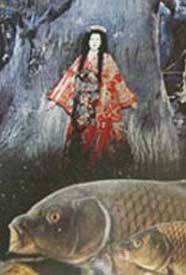 Demon Pond (Yashagaike, 1979) is based on a Meiji era fairy play by Izumi Kyoka (1873-1939), who based his tale on a legend of the actual Yashaga Pond, a tiny round lake in northern Japan, a couple of hours from the city of Fukui. Demon Pond (Yashagaike, 1979) is based on a Meiji era fairy play by Izumi Kyoka (1873-1939), who based his tale on a legend of the actual Yashaga Pond, a tiny round lake in northern Japan, a couple of hours from the city of Fukui.
Director Masahiro Shinoda did not have his heart in this film production throughout the process, & did not do a perfect job. He did not enjoy working with the prima donna Tamasaburo Wakayama, at the time Japan's most famous onnagata or kabuki player of female roles.
Kabuki make-up & the distance of the live stage are friendlier to the impersonation than a film camera. An onnagata can have a long stage career, & even a faggy old geezer can pull it off for a near-sighted audience. But for cinema, it was already a bit late for Tamasaburo to entirely pull this off in camera close-ups.
Tamisaburo was personally horrified when he saw daily rushes, discovering the camera did not show him to be nearly as feminine as did the stage. So he demanded re-shoots with heavier lens filters.
Hasty reshoots & the general vanity of the project did not thrill Masahiro whose deadline & budget did not permit such delays without effecting the film's quality. The heavy fuzzing which will be noticed of the picture was required to please Tamasaburo.
At times the lens filtering is so overdone that the filmstock ends up looking like it was blown up from an 8-mm camera, with grainy apperance. We'll never know if Tamasaburo could've pulled it off without fuzzing out the portrait; he seemed pretty certain he could not.
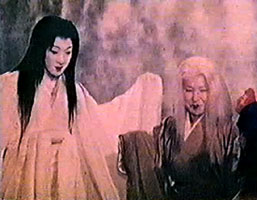 That's not to say Tamasaburo is unconvincing as Yuri. Many viewers would never suspect Yuri is an onnagata, especially given the unfocused look over-filtering has provided. That's not to say Tamasaburo is unconvincing as Yuri. Many viewers would never suspect Yuri is an onnagata, especially given the unfocused look over-filtering has provided.
So when this film premiered in Seattle long decades ago, a local critic without any beforehand-knowledge of the film gave the "actress" a pretty good review without noticing she was an onnagata player.
When Tamasaburo's performance is compared to, say, the harsh & the worn-out-haridan performance of Akihiro Miwa in the high camp Black Lizard (Kurotokage, 1968), Bando wins hands down, unless trashiness happens to be preferred, in which case Black Lizard wins.
It must also be said that Oshima, enormus talent that he is capable of being, nevertheless utterly failed previously on a fantasy film called Himiko (1974) set at the dawn of Japanese history.
So blaming Tamasaburo for any limitation for Demon Pond may just have been the easy excuse for Oshima. Even with faults, it has many scenes that are stunning, & even its worst moments are vastly better than Himiko which showed heroic fantasy not to be Oshima's forte.
Also despite the film's faults, there's a genderbending sexiness to the key performance. Tamasaboro especially when photographed from any distance -- such as when kneeling by the pond going through several slow stylized & idealized feminine motions from his onnagata training -- has decided appeal.
And there's an interminal tea ceremony that exists exclusively to show off the mannered movements of a champion onnagata. So too the "sacrifice" of the demure Yuri as she lays across a horse, hair dangling, does not require overly revealing close-ups, & again has a gorgeous artifice to it.
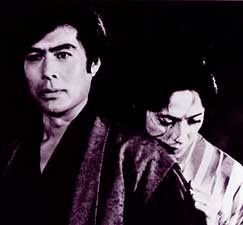 The time is 1933. Tamazawa Gakuen (Tsutomo Yamazaki) travelling from the south is searching for his vanished friend Akira (Go Kato), who, it turns out, has settled down with Yuri as hermits near Demon Pond. There's a definite sensuality to the teasing romance, perhaps faggotier than intended but very nice even so. The time is 1933. Tamazawa Gakuen (Tsutomo Yamazaki) travelling from the south is searching for his vanished friend Akira (Go Kato), who, it turns out, has settled down with Yuri as hermits near Demon Pond. There's a definite sensuality to the teasing romance, perhaps faggotier than intended but very nice even so.
Tamasaburo is playing a dual role, such as is common in kabuki theater. As the maiden Yuri, Tamasaburo attempts (and under such heavy lens-filtering achieves) the visual & dramatic effect of an actual actress. Then there is flambouyant dragon princess Shirayuki, which performance allows for a kabuki overplay.
The first half of the film is rather realistic in a romantic way, with only a few mystical intimations & a sense of timelessness so that 1933, in this mountain place, could as easily have been 1633. The second half of the film goes into arch fantasy mode.
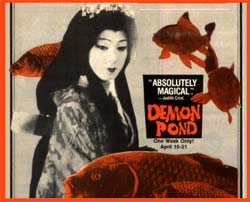 The village is experiencing drought, though higher on the mountain there's plenty of water in the lake. Where water is concerned, however, it's an all or nothing proposition, however; for the Dragon Princess of Demon Pond is propitiated three times every day with temple bells, to keep her from leaping out of the pond in the form of a flood that would easily eradicate the village. The village is experiencing drought, though higher on the mountain there's plenty of water in the lake. Where water is concerned, however, it's an all or nothing proposition, however; for the Dragon Princess of Demon Pond is propitiated three times every day with temple bells, to keep her from leaping out of the pond in the form of a flood that would easily eradicate the village.
The Dragon Princess desires to travel to a larger body of water at the mountain's base, in order to join her groom in marriage, though this journey would wipe out many lives along her route. For so long as the bells bind her to the pond, she cannot be wed.
Akira, Yuri's lover, is responsible for the bellringing duties. He doesn't really believe in such superstitions; he's merely in love with the maiden Yuri who lives by the pond, & a job is a job. This job allows him to be with her.
The snarky villagers decide to make a human sacrifice to end the drought, selecting the mountain-dwelling Yuri. About the same time the temple bell is destroyed, & in the pond, Princess Shirayuki is enthused to realize she can join her beloved.
The film takes on a wonderful charm at that midway point when some of the lake's creatures begin to appear in the film, the first being a catfish (Norihei Miki) & his companion the crawfish (Fujio Tokita) who are first to realize their demon-forms are no longer compelled to remain in the pond.
They & several other side-characters are the most endearingly costumed. These will obviously appeal to children, but really the film achieves its greatest poignancy treating these fairy-creatures with abrupt adult seriousness.
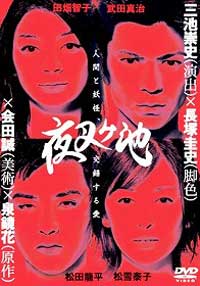 There's a real sense of the tragic when eventually they are driven back into the captivity, as they kind of merited their liberty. There's a real sense of the tragic when eventually they are driven back into the captivity, as they kind of merited their liberty.
The climactic unleashing of Demon Pond's waters alas is done with inferior miniatures, perhaps because the budget had been used up on the reshoots at vanity's commandments.
It weakens the effect of the whole film to end with FX good enough for a preschoolers' telefilm but not for a great director like Oshima.
Takashi Miike, best known for direct-to-video horror & gangster flicks, directed a live stage version of Demon Pond in autumn of 2005, modernizing the look so that it is kabukiesque rather than purely kabuki.
After the live run, Miike rearranged the performances a bit to fit on film. It had good distribution on dvd in Europe but was long delayed for a North American release, though it has finally become widely available. A review is being prepared, to add to this page.
copyright © by Paghat the Ratgirl
|
